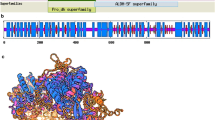Abstract
Pseudomonas solanacearum utilized phenylalanine as sole source of carbon and nitrogen. Phenylalanine-grown cells rapidly oxidized phenylacetic acid and homogentisic acid. Gentisic and protocatechuic acids were also oxidized, after an initial lag. Phenylacetate-grown cells rapidly oxidized gentisic acid, slowly oxidizedo-hydroxyphenylacetic acid and catechol, and did not oxidizem-hydroxymandelic andm-hydroxyphenylacetic acids. Phenylalanine was degraded via phenylacetic acid-r-lactone andβ ketoadipate; Rothera’s test indicatedortho cleavage of the aromatic ring.
Similar content being viewed by others
References
Mahadevan, A. (1991, inBiochemical Aspects of Plant Disease Resistance, Vol II.Post Defence Mechanisms. Today and Tomorrow, New Delhi, India.
Agrawal, P. and Mahadevan, A. (1981),Curr. Sci. 50, 1043.
Kunita, N. (1956),Med. J. Osaka Univ. 6, 703–708.
Cooper, R. A. and Skinner, M. A. (1980),J. Bactriol. 143, 302–306.
Sparnins, V. L., Chapman, P. J., and Dagley, S. (1974),J. Bacteriol. 120, 159–167.
Hareland, W. A., Crawford, R. C., Chapman, P. J., and Dagley, S. (1975),J. Bacteriol. 121, 272–285.
Dye, D. W. (1958),Nature (London)182, 1813–1814.
Mahadevan, A. and Sridhar, R. (1986), inMethods in Physiological Plant Pathology, Sivakami, Madras, India.
Abitha Devi, N., Kutty, R. K., Vasantharajan, V. N., and Subbarao, P. V. (1975),J. Bacteriol. 122, 866–873.
Arunakumari, A. and Mahadevan, A. (1981),J. Sci. Ind. Res. 40, 188–199.
Kunita, N. (1955),Med. J. Osaka Univ. 6, 697–702.
Chapman, P. J. and Dagley, S. (1962),J. Gen. Microbiol. 28, 251–256.
Dagley, S., Fewster, M. E., and Happoled, F. C. (1952),J. Bacteriol. 63, 327–336.
Dagley, S. and Wood, J. M. (1965),Bio. Chem. Bio. Phy. Acta. 99, 383–385.
Actachi, K., Takeda, Y., Senoh, S., and Kita, H. (1964),Bio. Chem. Bio. Phy. Acta 93, 483–493.
Blakley, E. R., Kurz, W., Halvorson, H., and Simpson, F. J. (1967),Can. J. Microbiol. 13, 147–157.
Author information
Authors and Affiliations
Rights and permissions
About this article
Cite this article
Agrawal, P., Latha, S. & Mahadevan, A. Utilization of phenylalanine and phenylacetic acid byPseudomonas solanacearum . Appl Biochem Biotechnol 61, 379–391 (1997). https://doi.org/10.1007/BF02787809
Received:
Accepted:
Issue Date:
DOI: https://doi.org/10.1007/BF02787809




